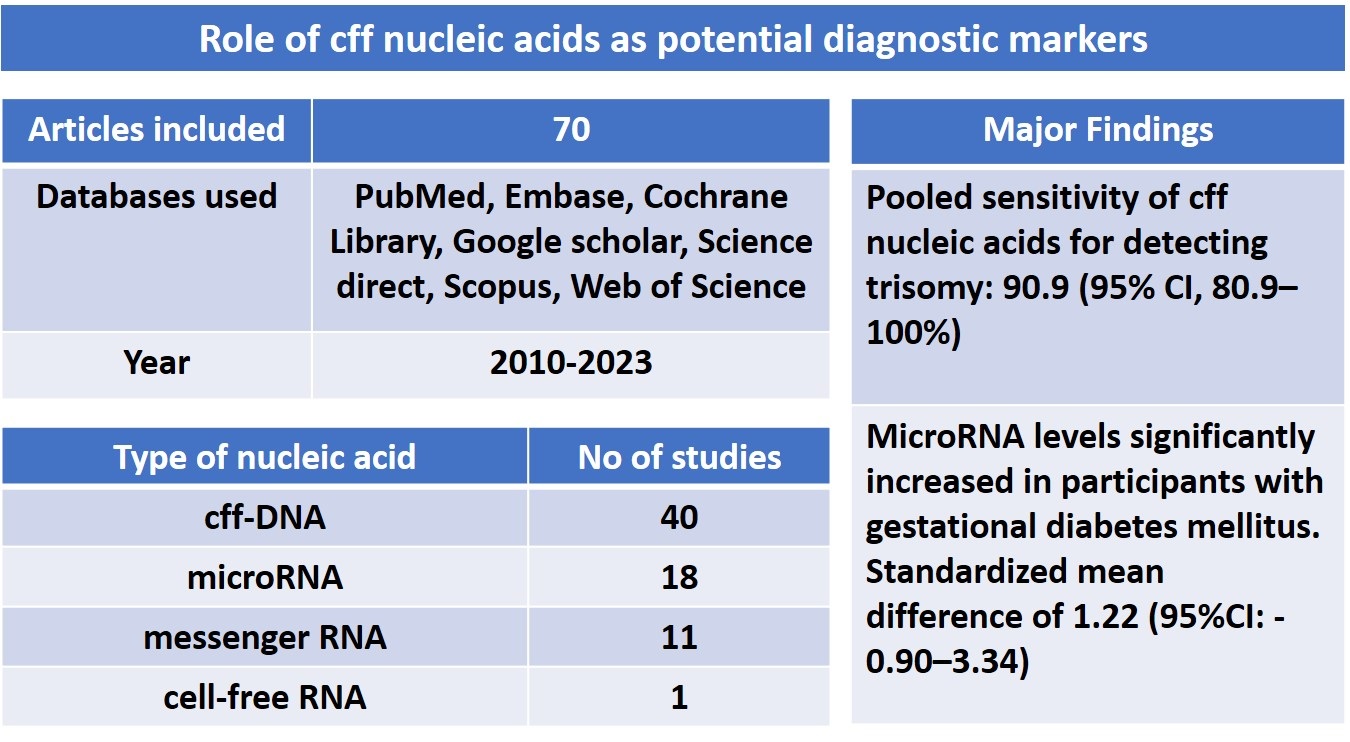Sun, Dec 14, 2025
[Archive]
Volume 23, Issue 2 (February 2025)
IJRM 2025, 23(2): 111-130 |
Back to browse issues page
Download citation:
BibTeX | RIS | EndNote | Medlars | ProCite | Reference Manager | RefWorks
Send citation to:



BibTeX | RIS | EndNote | Medlars | ProCite | Reference Manager | RefWorks
Send citation to:
Keshari J R, Prakash P, Sinha S R, Prakash P, Rani K, Aziz T et al . Diagnostic potential of cell-free fetal nucleic acids in predicting pregnancy complications: A systematic review and meta-analysis on trisomy, pre-eclampsia, and gestational diabetes. IJRM 2025; 23 (2) :111-130
URL: http://ijrm.ir/article-1-3340-en.html
URL: http://ijrm.ir/article-1-3340-en.html
Jiut Ram Keshari *1 

 , Pritam Prakash2
, Pritam Prakash2 

 , Seema Rani Sinha2
, Seema Rani Sinha2 

 , Prem Prakash3
, Prem Prakash3 

 , Kirti Rani2
, Kirti Rani2 

 , Tarique Aziz4
, Tarique Aziz4 

 , Shaily Shilpa2
, Shaily Shilpa2 




 , Pritam Prakash2
, Pritam Prakash2 

 , Seema Rani Sinha2
, Seema Rani Sinha2 

 , Prem Prakash3
, Prem Prakash3 

 , Kirti Rani2
, Kirti Rani2 

 , Tarique Aziz4
, Tarique Aziz4 

 , Shaily Shilpa2
, Shaily Shilpa2 


1- Department of Biochemistry, Indira Gandhi Institute of Medical Sciences, Patna, Bihar, India. , jiutram@rediffmail.com
2- Department of Biochemistry, Indira Gandhi Institute of Medical Sciences, Patna, Bihar, India.
3- Department of General Surgery, Indira Gandhi Institute of Medical Sciences, Patna, Bihar, India.
4- Department of Biochemistry, Rajendra Institute of Medical Sciences, Ranchi, Jharkhand, India.
2- Department of Biochemistry, Indira Gandhi Institute of Medical Sciences, Patna, Bihar, India.
3- Department of General Surgery, Indira Gandhi Institute of Medical Sciences, Patna, Bihar, India.
4- Department of Biochemistry, Rajendra Institute of Medical Sciences, Ranchi, Jharkhand, India.
Abstract: (834 Views)
Background: Recent studies reveal an association between increased cell-free fetal (cff) nucleic acid in maternal blood and pregnancy challenges like loss, pre-eclampsia, growth restriction, and preterm labor.
Objective: This article assesses the role of cff nucleic acids as potential diagnostic markers for the prediction and monitoring progression of severe pregnancy-related complications.
Materials and Methods: In this systematic review and meta-analysis, various databases were searched. Original articles reporting on the role of cff nucleic acids in predicting the complications of pregnancy were included. I square test and funnel plot were used to analyze heterogeneity and publication bias, respectively. The quality of studies was assessed using the critical appraisal checklists for studies created by the Joanna Briggs Institute.
Results: 70 publications were selected for the final qualitative analysis. Articles were published between 2010 and 2023, and most studies were conducted in the USA and China. The majority of studies were conducted on the quantity of cff-DNA (n = 40), and the remaining on microRNA (n = 18), messenger RNA (n = 11), and cell-free RNA (n = 1). The pooled sensitivity of cff nucleic acids for detecting trisomy was found to be 90.9 (95% CI: 80.9-100%). MicroRNA levels were significantly increased in participants with gestational diabetes mellitus, with a standardized mean difference of 1.22 (95% CI: -0.90-3.34).
Conclusion: Fetal nucleic acids can serve as accurate noninvasive diagnostic tools for predicting serious complications during pregnancy.
Objective: This article assesses the role of cff nucleic acids as potential diagnostic markers for the prediction and monitoring progression of severe pregnancy-related complications.
Materials and Methods: In this systematic review and meta-analysis, various databases were searched. Original articles reporting on the role of cff nucleic acids in predicting the complications of pregnancy were included. I square test and funnel plot were used to analyze heterogeneity and publication bias, respectively. The quality of studies was assessed using the critical appraisal checklists for studies created by the Joanna Briggs Institute.
Results: 70 publications were selected for the final qualitative analysis. Articles were published between 2010 and 2023, and most studies were conducted in the USA and China. The majority of studies were conducted on the quantity of cff-DNA (n = 40), and the remaining on microRNA (n = 18), messenger RNA (n = 11), and cell-free RNA (n = 1). The pooled sensitivity of cff nucleic acids for detecting trisomy was found to be 90.9 (95% CI: 80.9-100%). MicroRNA levels were significantly increased in participants with gestational diabetes mellitus, with a standardized mean difference of 1.22 (95% CI: -0.90-3.34).
Conclusion: Fetal nucleic acids can serve as accurate noninvasive diagnostic tools for predicting serious complications during pregnancy.
Type of Study: Review Article |
Subject:
Reproductive Genetics
Send email to the article author
| Rights and permissions | |
 |
This work is licensed under a Creative Commons Attribution-NonCommercial 4.0 International License. |





